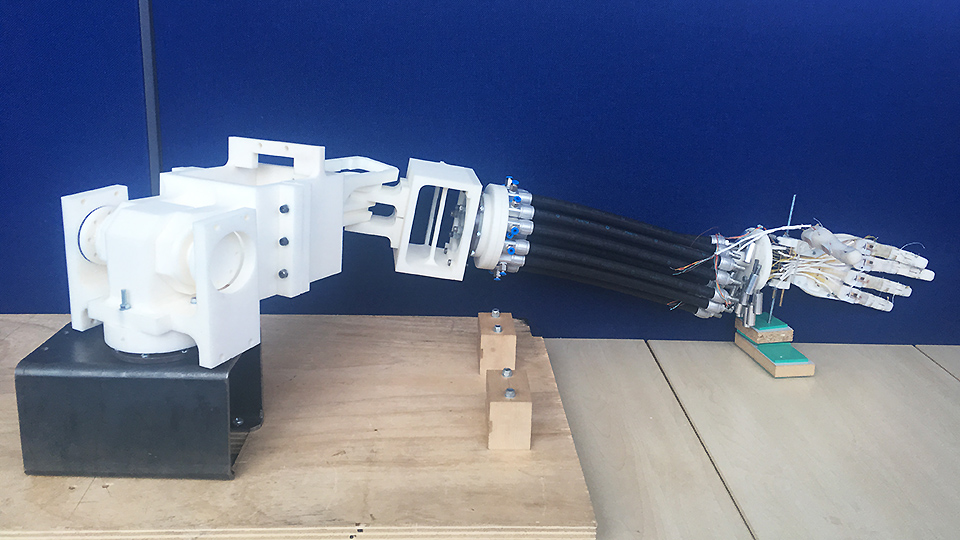The world’s first ambidextrous robot hand and arm have been developed by researchers at Brunel University London, with the ultimate aim of helping thousands of amputees who experience phantom limb pain.
After revealing a 3D-printed ambidextrous robot hand in 2014, Dr Tatiana Kalganova (Department of Electonic and Computer Engineering, College of Engineering, Design and Physical Sciences), PhD Student Mashood Mukhtar and a team of Brunel students have continued to develop an ambidextrous robot arm that offers greater flexibility and range of motion in the shoulder, elbow and wrist than a human arm.
Over the last few decades, robotic hands have become significantly more sophisticated in mimicking human behaviour so they can be used for biomedical purposes, or for use in dangerous situations – the defusing of bombs, manipulating objects in aerospace, or for use in radioactive environments, for example.
But Brunel’s design is believed to be the first to imitate both left and right hand gestures. Its fingers can curl in one way or the other, representing behaviours that are beyond the physical capability of human beings.
Phantom limb pain is a frequent and persistent problem following amputation and reducing it in the long-term requires therapeutic interventions such as mirror therapy. A mirror is used to create a reflective illusion to induce pain relief in the afflicted limb, but the problem with this type of therapy is that the patient cannot carry a mirror all the time. And in many cases, the treatment is not effective.
The research team believe that delivering rehabilitation services over the internet is highly practical and the most cost effective and efficient way of supporting long-term self-management of patients with phantom limb pain. Patients can access the robot arm over the internet using any smart device from anywhere in the world.
The ambidextrous hand/arm could ease amputees’ phantom limb pain by tricking the patient’s brain into interpreting the movement as that of the missing limb. And because the robot limbs are ambidextrous, all potential patients – regardless of which side their injured limb is on – could use the same robot arm.
As well as exploring potential therapeutic benefits for rehabilitation and physiotherapy after injury, amputation or stroke, the team behind the robot limb has also worked with the performance artist Stelarc, whose works focus heavily on extending the capabilities of the human body through cyborgisation and other human-machine interfaces.
With its current design, the Brunel ambidextrous arm offers a shoulder rotation of 360° degrees, compared to a typical human rotation of 70°. The arm’s shoulder flexion/extension is 360°, compared to a little over 200° in a typical human and the shoulder abduction/adduction is 190° - similar to a human arm.
At 270°, the robot’s elbow has nearly twice the flexibility of a human arm and can bend both ways, while wrist flexibility is also significantly advanced compared to the human body. Forearm pronation/suspension is 360° compared to human arm offering just 150°.

Parts have been 3D-printed from lightweight plastics to provide optimal strength and flexibility. The hand and arm are actuated by pneumatic artificial muscles, the lengths of which vary according to the compressed air flowing in and out. Air flow is controlled by valves connected to both the pneumatic circuit and an electronic interface, with delivered voltages turning the valves on and off to control the contraction rate of muscles.
Control functions are stored in a microcontroller and accessible from a remotely controlled system, so the hand and arm can be controlled from a website or Facebook app. This has the added benefit of becoming a social space for phantom limb pain sufferers to use the robot arm for physiotherapy at home, while also discussing issues and sharing thoughts on the experience with others.
Approximately 65% of amputees – of which there are some 700,000 in Europe alone – develop phantom painful sensations where amputated limbs have been removed, and for many this can stop sleep, social activity and work.
The Brunel robotic hand is a collaborative project, first designed in 2011 and exhibited as a multidisciplinary team submission for the annual Made in Brunel showcase in 2013. Dozens of former and current Brunel students and students on exchange programs from France and Brazil have contributed toward its continued development.
(2013 video of the robot hand in action)
Reported by:
Sarah Cox,
Media Relations
sarah.cox@brunel.ac.uk